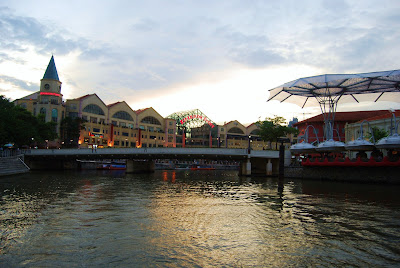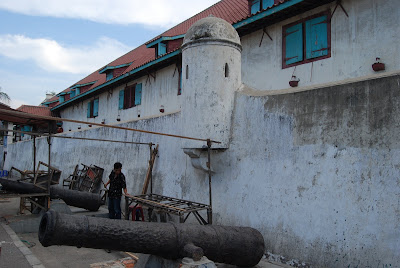
First stop, the Singapore River cruise, which leaves from Clark Quay. Named after Sir Andrew Clarke, Singapore's second Governor and Governor of the Straits Settlements from 1873 to 1875, it positioned Singapore as the main port for the Malay states of Perak, Selangor and Sungei Ujong.

My last visit to CQ was about 20 years ago when the first redevelopment program of transforming the old shop houses into a cluster of quaint restaurants and pubs took place.
Having strength in numbers, a large group of Mandarin-speaking tourists led by an aggressive tour leader bull-dozed ahead of us.
Who says English is the most important language in the world? But as luck would have it, the English tour being less popular had a boatload of only 6 passengers. And so in peace and quiet we slipped into the setting sun!

The scenic trip traverses under at least 3 bridges.
The Fullerton Hotel has a colourful history, with beginings as Fort Fullerton in 1820, strategically positioned to protect the colony from intruders. In 1867 it was converted to the General Post Office Building.
By 1919 the real estate value had risen and an extravagant project or rebuilding, costing $4 million, was undertaken by the then Governor, Sir Hugh Clifford. A British architect from England with aspirations of practicing his skills in classical Greek architecture, (after having gone to town with the Mogul style in Kuala Lumpur perhaps!) tore down the Aberdeen granite turrets and up went the Doric columns.

Formula One's first night race was held in Singapore on 28 September 2008, estimated to draw 80,000 spectators, but actually packed in 100,000, which exceeded other F1 events. The F1 Grand Stand and track is set around the Bay.
As we approached the mouth of the Singapore River, the Esplanade-Theatres on the Bay came into view. Initially described as "two copulating aardvarks" as the original drawing comprised two unadorned glass cases covering the theatres.

The projected date of completion is end 2009, however recent rumours foretell money woes to the tune of S$2 billion resulting in project delays.
 On the return trip, a bejewelled skyline and reflection on the Bay carves and elegant picture.
On the return trip, a bejewelled skyline and reflection on the Bay carves and elegant picture.  Not forgetting the signature Merlion . . .
Not forgetting the signature Merlion . . .  And another charming bridge.
And another charming bridge.  The Asian Civilisations Museum stands across from the Fullerton Hotel. Well lit at night, it definitely attracted me enough to plan a visit the next day.
The Asian Civilisations Museum stands across from the Fullerton Hotel. Well lit at night, it definitely attracted me enough to plan a visit the next day. 
 A fearsome bungee jump contraption guarantees the jump of your life back in Clark Quay.
A fearsome bungee jump contraption guarantees the jump of your life back in Clark Quay.








 In 1740, Chinese migrants were moved
In 1740, Chinese migrants were moved 







 Pasar Ikan (Fish Market) was elusive to us as signage to this important site was lacking.
Pasar Ikan (Fish Market) was elusive to us as signage to this important site was lacking.



 Fast forward to the present. The middle class of Indonesia amounts to 10% of the population.
Fast forward to the present. The middle class of Indonesia amounts to 10% of the population.  The number of cars per household was notably more than two. Pak Tarsono asked me if we in Malaysia also liked having eight cars, one for each of the kids, wife etc ?
The number of cars per household was notably more than two. Pak Tarsono asked me if we in Malaysia also liked having eight cars, one for each of the kids, wife etc ?  So too were the satellite dishes, or parabolas as Pak Tarsono called them, on the rooftops.
So too were the satellite dishes, or parabolas as Pak Tarsono called them, on the rooftops.




















